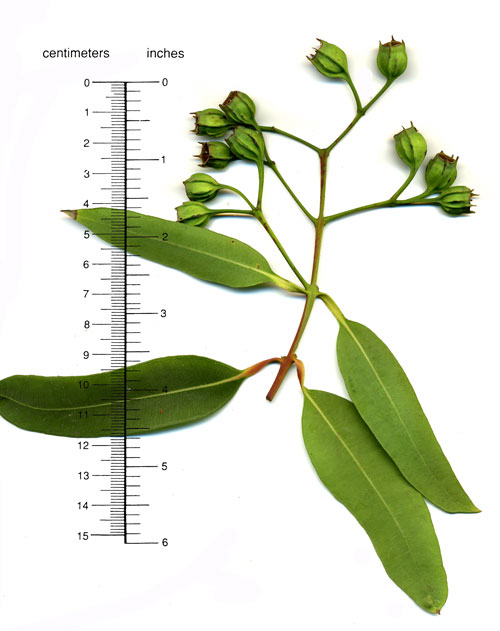Angophora costata
 smooth-barked apple
smooth-barked apple
A striking and relatively common tree in Australia, often reaching impressive girth on almost soil-free sandstone, and generally regarded as a gum tree (or eucalypt) by the inhabitants, as witnessed by the common names red gum and rusty gum that refer to the bark color at peeling. The bark is often streaked with reddish kino. The relationship with Corymbia ficifolia (syn. Eucalyptus ficifolia), the red-flowering gum, is closer than that existing between some species placed within Eucalyptus; however, the crushed leaves are devoid of aroma.
It has opposite leaves and tiny white petals. The sharply ribbed seed capsules have five ribs terminating in teeth.
A sizable Angophora used to be located 13 yards south of Palm Drive’s east entry gate at El Camino Real and 25 yards in from the bike path, and could be compared with adjacent eucalypts. As a fine specimen in a fine location, it would have seemed to deserve occasional pruning. As it happened, it was removed fall 2009, diseased.
A 1962 specimen on Serra Street between the Recycling Center and Pampas Lane, which by 2003 had become an area of neglect, is conspicuous as the tallest tree thereabouts. The tallest rusty gum in the United States, at Honaunau Forest Reserve, Hawaii, had reached 132 feet in 1969.
Illustrations: Specimen near Palm Drive (now removed) | distinctive smooth, pinkish bark.
Name derivation: Angophora – Gk. aggeion (a vessel) and phoreo (to carry in, in reference to the shape of the fruit); costata – ribbed.
About this Entry: The main text of this entry is from the book Trees of Stanford and Environs, by Ronald Bracewell, published 2005. John Rawlings noted Arboretum specimen’s removal (2009). Light edits Nov 2017 (SP).





